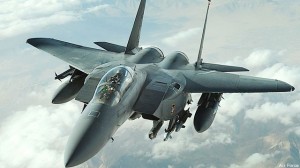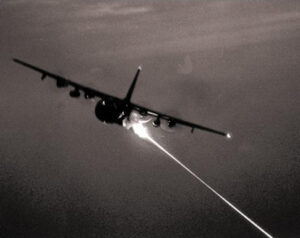
A laser experiment at the Air Force Research Laboratory
TYSON’S CORNER: All branches of the military really want laser weapons. But they don’t all want them for the same missions. What struck me after a recent conference here was how differently the US Air Force is approaching lasers.
The USAF is pursing a two-pronged approach: They want to mount lasers on both the large AC-130 gunship and a smaller fighter, probably the relatively roomy F-15E Strike Eagle. Neither prong leads to the kind of missile defense system that’s the holy grail for the Army and the Navy. Instead, the Air Force wants lasers, initially, to shoot down incoming anti-aircraft weapons and, ultimately, to attack both flying and ground targets.
All told, both the technical hurdles and the tactical applications for the Air Force are significantly more challenging than the other services’ laser efforts.
“They are trying to do the hardest thing first,” future warfare expert Mark Gunzinger told me.

F-15E Strike Eagle
Technically, it’s a lot easier to fit a laser weapon on a ground base, a Navy ship, or even an Army truck than in an airplane, especially one as small as a fighter, where every ounce counts and every component vibrates during flight. The world’s first and only operational laser weapon happens to be installed aboard the USS Ponce, which displaces almost 17,000 tons. By contrast, the Air Force AC-130J weighs 82 tons fully loaded, the F-15E just 40.
Tactically, for the Army, Marine Corps, and the Navy, lasers are primarily defensive. The Army’s truck-borne High-Energy Laser Mobile Demonstrator (HEL-MD), the Marine’s Humvee-mounted Ground-Based Air Defense (GBAD), and the Navy’s Laser Weapon System (LaWS) are designed to shoot down incoming artillery shells, rockets, and drones, although LaWS can burn out the motors of fast attack boats as well. The ultimate objective is a laser with the power and range to shoot down incoming ballistic and cruise missiles, protecting a base, ground unit, or naval task force.
The Air Force mindset is a little more aggressive. “My customer is the enemy. I deliver violence,” said Lt Gen. Brad Heithold, head of Air Force Special Operations Command, at the directed energy conference. While the 105 millimeter cannon on his AC-130 gunships today gives him plenty of killing power, Heithold said, he’d like to add the option of a laser weapon that’s pinpoint-precise and capable of dialing energy up or down to be more or less destructive as needed.
“Directed energy gives you that opportunity to be much more lethal,” said the vice-chief of Air Combat Command, Maj. Gen. Jerry Harris. “Right now, when we talk about an air-to-air engagement, we measure it in miles and minutes,” he told the conference. “With directed energy, you change that to milliseconds.”
For comparison, an AIM-120 AMRAAM air-to-air missile flies at about 3,000 miles per hour. (The exact figure is classified). A laser moves at the speed of light, 186,000 miles per second.
What’s more, a laser only runs out of ammunition when you run out of electrical power. A single gallon of gas can power multiple blasts. So instead of carrying at most half-a-dozen supersonic missiles, a laser-armed aircraft could fire hundreds of shots that travel at the speed of light — and then rendezvous with an aerial refueling tanker to reload its weapons without ever landing.
Because lasers can fire an infinite number of light-speed shots, they’re ideal for intercepting high-speed threats. The Air Force is hardly blind to their defensive value. But the Air Force perspective on defense is narrower than the Army’s or Navy’s: Rather than try to protect a ship, a base, or a fleet, the USAF focuses on self-protection of the individual aircraft carrying the laser. (Indeed, aircraft already carry low-power infra-red lasers — DIRCM and LAIRCM — that can blind some heat-seeking missiles, although not radar-guided ones). Such defenses could keep aircraft alive in the danger zones of a Chinese-style “anti-access/area denial” defense.
The Air Force also sees lasers as multi-purpose offensive/defensive weapons that can fire in a low-power mode for self-defense, then dial up to a non-lethal offensive mode — burning out sensors or engines, for example — or all the way to “kill.”
“I used to think offensive first and foremost,” Heithold said. But after talking to industry about the art of the possible, he went on, he came to realize that “a single laser can be defensive and offensive,” depending on the power applied.
“Directed energy can be used against weapons coming at us but also used to go after the shooter,” Harris said. Near-term lasers may not have the raw power to blow an enemy aircraft out of the sky, but they could burn out its radar and other electronics.

AC-130J gunship
“It is possible in the near term to develop and field the next generation of laser defenses that will burn out, not just blind, sensors on SAMs [surface-to-air missiles] and air-to-air-missiles,” said Gunzinger, a former Air Force pilot now at the Center for Strategic and Budgetary Assessments, which co-sponsored the conference. In fact, lasers would be especially effective against the most advanced missiles, those with sensitive multi-mode sensors. “Within the next five years,” he told me, “we could have 150-plus kW lasers on aircraft, [starting] on gunships and bombers.”
The Air Force, however, is focused on fighters. That’s a tighter fit than gunships or bombers, so the Air Force Research Laboratory has a relatively cautious three-phase plan, AFRL commander Maj. Gen. Thomas Masiello said at the conference:
- A defensive system with “tens of kilowatts” of power called SHIELD, the Self-protected HIgh-Energy Laser Demonstration. It will be demonstrated circa 2020.
- A longer-range defensive system with 100 kilowatts of power, to be demonstrated in 2022.
- A 300-kilowatt offensive system capable of destroying enemy aircraft and ground targets at long range.
All these systems will be weapons pods or other external add-ons to existing aircraft, not “fully integrated” inside the airframe like a gun or radar, Masiello cautioned. That means radar-evading aircraft like the F-35 or F-22 couldn’t use them without sacrificing stealth. “We’re talking decades to have some sort of a 300-kw laser possibly integrated into a fighter,” he said.
The SHIELD demo will also look at engaging “soft” ground targets on behalf of Lt. Gen. Heithold and Air Force Special Operations Command. “Soft” wasn’t clearly defined, but it probably means sensors, communications equipment, and other delicate but high-value systems.
After SHIELD, though, it seems likely the fighter laser and the gunship laser will diverge, since the AC-130 has so much more space, weight, and power available. Special Operations is also famous for getting new technology into the field faster than the regular military, albeit in small quantities.
On an AC-130, “it is relatively easy to give up 5-10,000 pounds of weight to this,” Hehithold said. A gunship with a high-energy laser is just “a couple of years out,” he said. For the Air Force laser effort as a whole, he said, “that might be where we start.”
In a ‘world first,’ DARPA project demonstrates AI dogfighting in real jet
“The potential for machine learning in aviation, whether military or civil, is enormous,” said Air Force Col. James Valpiani. “And these fundamental questions of how do we do it, how do we do it safely, how do we train them, are the questions that we are trying to get after.”


























